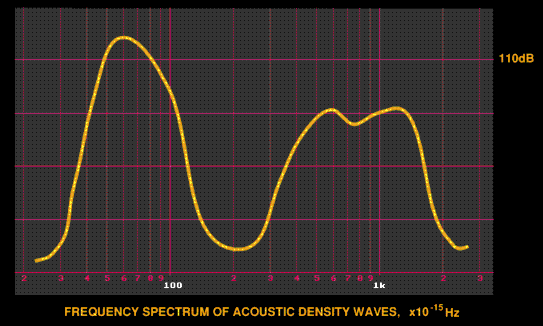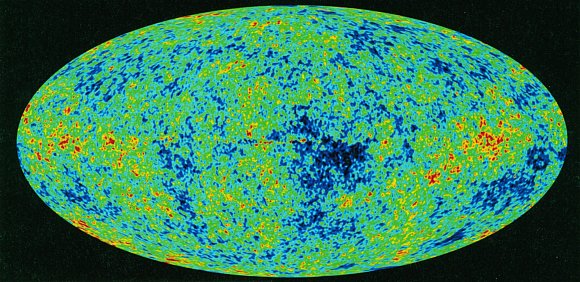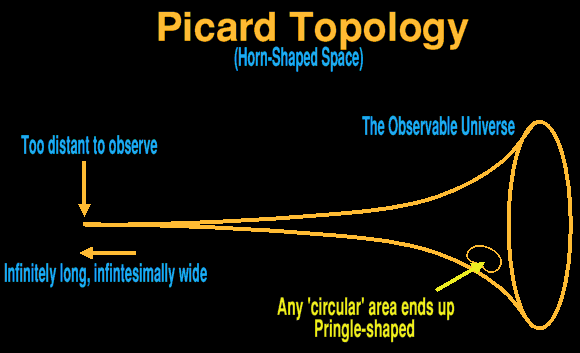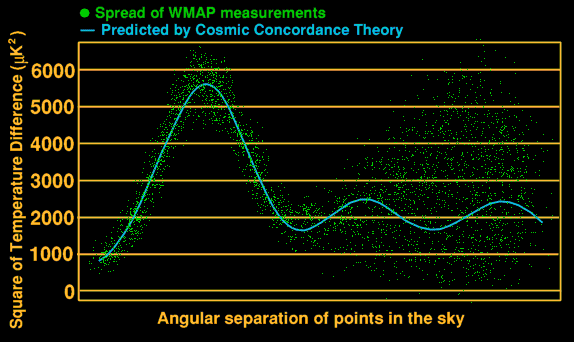



|
The Microwave Anisotropy All-Sky Map of the Universe, after subtracting the asymmetry caused by local movement through the frame of reference. From the Wilkinson Microwave Anisotropy Probe (WMAP), AD2003 data. The difference between the red and black areas is just 200 micro Kelvin. There appears to be no hot or cold areas subtending an angle greater than 60 degrees. Moreover, all hot or cold areas seem to be not circular but oval in shape. These two observations seem to support the hypothesis that space is trumpet shaped, flared at one end and tapering down to a narrow point at the other end; called a Picard space, this is hyperbolic, where any circular section is shaped like a pringle, oval in area and doubly and oppositely curved. Worryingly, there are some large-scale octopole and quadrapole symmetries in the WMAP data aligned with our Solar System. |

| Picard Space is just one of many possible morphologies of hyperbolic spaces. The Picard space tapers down at one end to an infintesimal point that is infinitely distant from the open end, but it is so narrow as to enclose a finite volume. An observer approaching the extreme of tapered point would eventually see the back of his own head. One travelling the other way on the outside surface of the flare and going beyond the open mouth would fold over onto the inside of the flare and travel back down to the tapered end. Any one piece of the horn is saddle shaped, that is, possesses negative curvature, it is bent up in one direction and down in the perpendicular direction, just like a Pringles potato crisp, or the saddle for riding a horse. The negative curvature of space would be like a distorting lens and would warp any circle into an elliptical shape, just as seen in the WMAP data of all hot or cold spots. Further observation of the microwave anisotropy will ascertain whether the elliptical shapes conform exactly with that expected if space were of Picard topology. If space turns out to Picard, then the present-day volume of the Universe is 1032 cubic light years. [It is 1031 cubic light years if space is flat]. Picard topology is named from a character in Star Trek. If space is flared then the Cosmological Principle, which says that the Universe is the same in all directions and all places, is false: space is decidedly anisotropic in Picard topology. |

| The so-called Cosmic Concordance Model fits the WMAP data best. The first peak relates to the Universes' curvature, and this fits the WMAP data well. The second peak, which relates to the amount of ordinary matter present in the Universe, is hardly discernible amongst the noise of the WMAP data, whilst the third peak, which determines the amount of dark matter in the Universe, is not resolved by the data at all. The Cosmic Concordance model ignores up to another two dozen parameters of the Universe, and assumes that neutrinos have zero mass (which is known to be false) and that there are no gravitational waves (now [2017] proven false - there are gravitational waves - and the most energetic are created either by the merger of two Black Holes or of Neutron Stars, or a combining of both). So, in all likelihood, this theory is fundamentally flawed. Another theoretician has shown that it takes 5 parameters to describe the WMAP data, and that the Universes' curvature is not amongst them. Place your bets now please. The European Space Agencies Planck satellite, due for launch in 2007, may help better measure the angular distribution of the microwave anistropy. |
The WMAP data of AD2003 implies that the Universe is composed of 72.8% dark energy, 22.7% dark matter, and just 4.6% baryons (ordinary matter). Nothing is yet known about the nature of dark energy nor of dark matter, but there is some speculation that a Ghost Condensate could explain both those and inflation too in one go. See also Baryons and Quarks.
The existence of Dark Energy in the Universe also accelerated the expansion of the Universe some 6 billion years ago. Dark Energy is repulsive in nature.
The other implications of the WMAP data are that the Universe is 13.81Gy ±0.03Gy old and is flat and very close to the Critical Density, being neither open (hyperbolically warped space) nor closed (spherically warped space), but Euclidean. Also, the very first stars to ignite in the Universe were very much unlike present day stars which have heavier elements within them. Being composed wholly of hydrogen and helium, the first-born stars were very much heavier than present-day stars, and they had much hotter cores and burnt fuel much more fiercely, lasting only a fraction of the time of present-day stars. These super-massive stars quickly exhausted their nuclear fuel and went supernovae, (providing us with the abundance of elements heavier than helium that we observe in the Universe today) appeared earlier than once thought, just 200 (±100%) Million years after the Big Bang (when the redshift, z, was 17 ±3). When the super-massive stars died out, a billion year dark period in the Universes history followed before new stars could gather from the dust of the supernovas. The Expansion Rate of the Universe, the Hubble Constant, now comes out at Ho=71 ±5% km/s/Mpc. The Microwave Background is also anisotropically polarized, providing clues that the Universe did indeed undergo a brief inflationary phase very early on just 10-35 seconds after its inception, where it briefly expanded at a phenomenal rate due to a phase change in the nature of space and energy. See Cosmological Constant.
The universe is not only expanding, but accelerating away from us. This acceleration will cause space to emit radiation, called de Sitter radiation, which drains energy away. Just like particle-pair creation at the event horizon of a black hole, de Sitter radiation consists of virtual particle pair creation at the observers horizon, the theoretical limit of the observers visible Universe; the boundary where beyond which space is expanding at faster than the speed of light. One virtual particle tunnels across the horizon, never to be seen by the observer again, and the other becomes a real particle in the observers visible Universe. Unlike Hawking radiation which is thermal, the frequency spectrum of de Sitter radiation only approximates to that of a black-body. Also, unlike Black Holes which get hotter as they radiate, the temperature of the observers Universe gets colder as it radiates de Sitter radiation because after radiating the particle, the new observers horizon shrinks. The reduction in the temperature of de Sitter space occurs because of the matter contained within it.
![]()
![]()